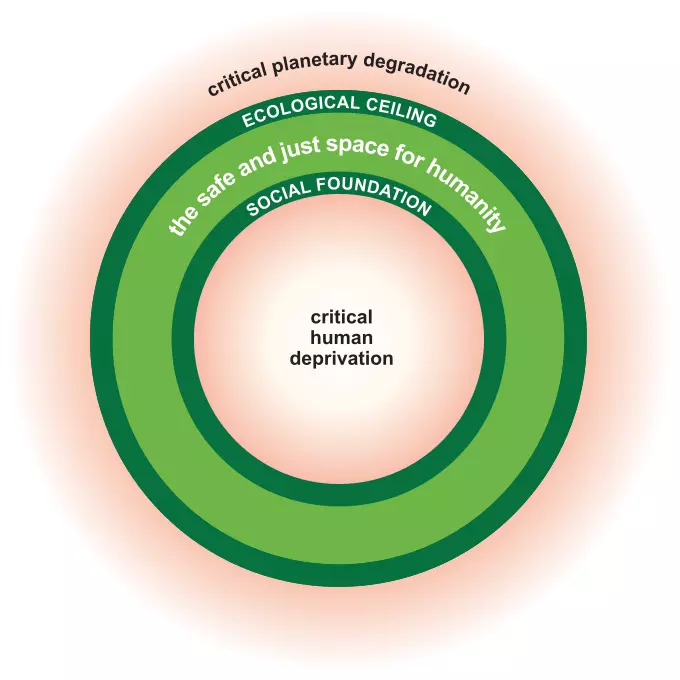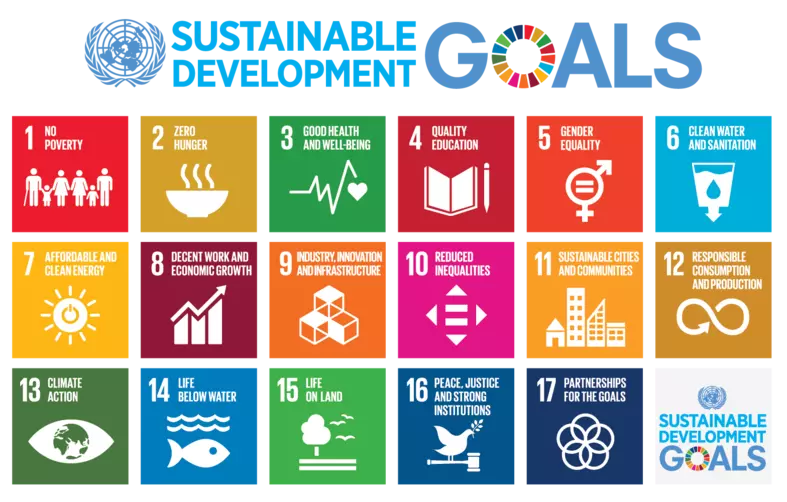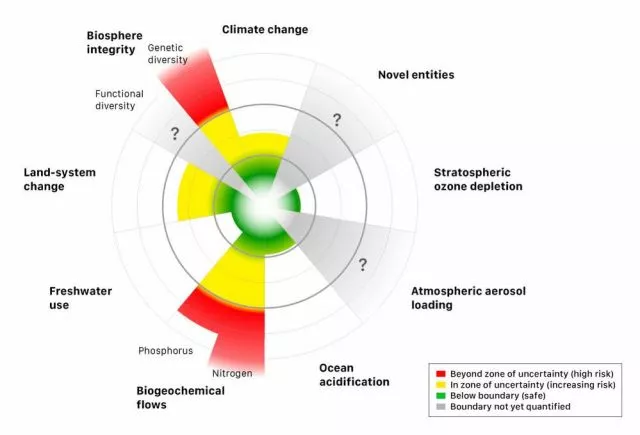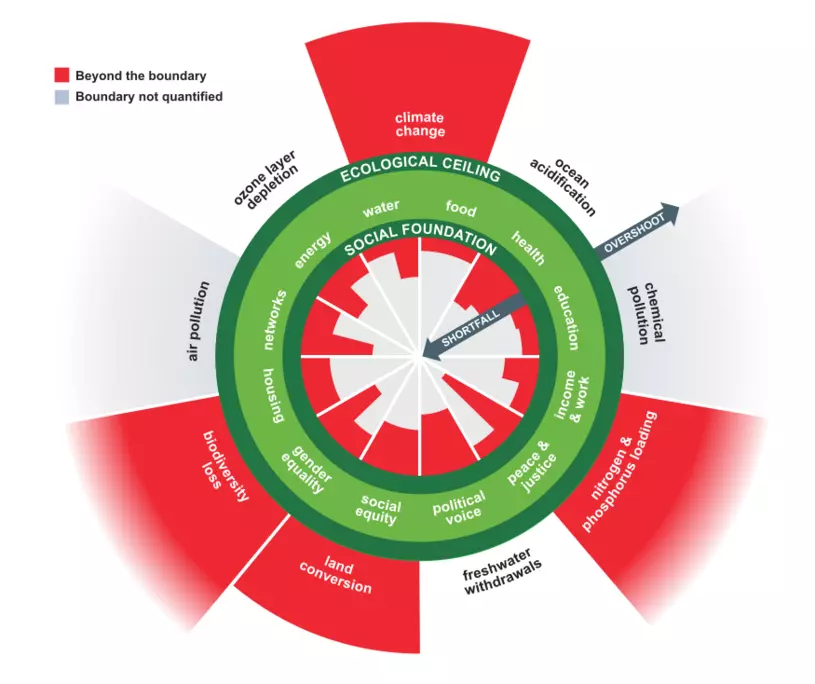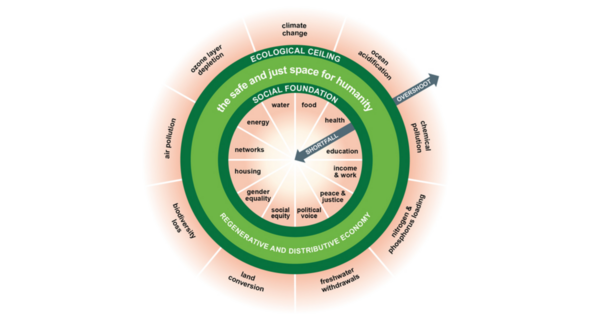
What is the Doughnut?
An introduction to the concept at the heart of Doughnut Economics

Version 1.0 (September 2020)
Overview
This tool is an introduction to the concept at the heart of Doughnut Economics. It's been designed as both a document that can be shared and a presentation that can be given in a classroom, a workshop or a meeting. Either download it as a pdf (below), open it within Google drive (links below) or scroll down to read on this page.
Links
Open as a document in Google Docs
Open as a presentation in Google Slides
What is the Doughnut?
Think of it as a compass for human prosperity in the 21st century, whose goal is to meet the needs of all people within the means of the planet.
It consists of two concentric rings:
- A social foundation – to ensure that no one is left falling short on life’s essentials.
- An ecological ceiling – to ensure that humanity does not collectively overshoot planetary boundaries.
Between these two boundaries lies a doughnut-shaped space that is both ecologically safe and socially just – a space in which humanity can thrive.
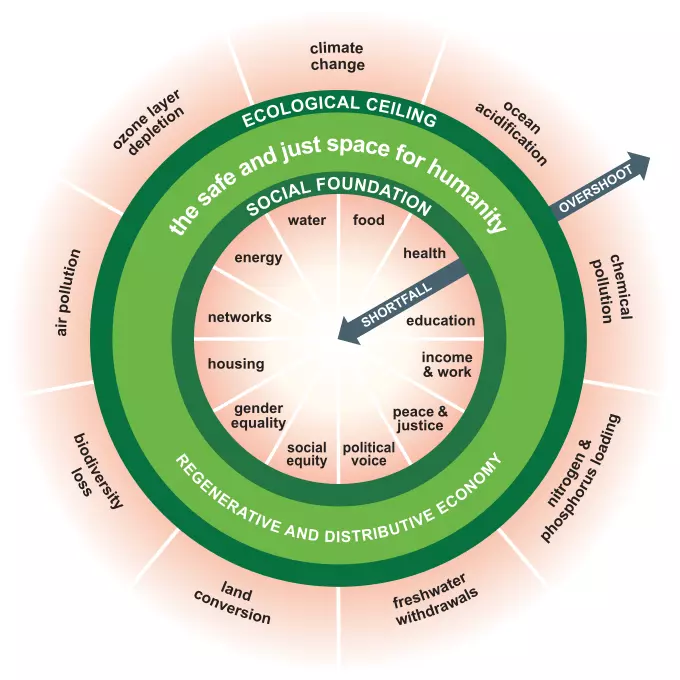
The essence of the Doughnut
1. The social foundation – below which lies critical human deprivation
2. The ecological ceiling – beyond which lies critical planetary degradation
These two boundaries are foundational in the sense that humanity should always seek to avoid critical human deprivation and critical planetary degradation. But how best to define their specific dimensions and measure their current status relative to desired outcomes will keep evolving over time.
The Doughnut’s dimensions
(as of 2017)
The Social Foundation
The 12 dimensions of the social foundation are derived from the social priorities agreed in the Sustainable Development Goals (UN, 2015).
The Ecological Ceiling
The 9 dimensions of the ecological ceiling are the nine planetary boundaries defined by Earth-system scientists (Steffen et al., 2015).
Quantifying the Doughnut
The image below reveals the current state of humanity and our planetary home: think of it as humanity’s ‘selfie’ in the early days of the 21st century.
Each dimension is measured, where possible, with 1 or 2 indicators, and the red wedges show the extent of shortfall and overshoot of the Doughnut’s social and planetary boundaries.
It shows us that millions of people still fall short on all 12 of the social dimensions, and that humanity has already overshot at least four planetary boundaries (air pollution and chemical pollution are currently unquantified).
To achieve the 21st century goal of meeting the needs of all within the means of the living planet means eliminating all of the red from the Doughnut diagram, and this must be done from both sides at the same time.
Find out more
- Explore the dimensions of the social foundation and ecological ceiling
- Explore the selection of these dimensions, including their limitations
- Read chapter one of Doughnut Economics: Seven Ways to Think Like a 21st-Century Economist
Share
Attachments
Share
-
Story

Doughnut economics on brillder
Our latest online learning module on brillder introduces students to doughnut economics
-
Story
.jpg)
Donut Brasil bursts into life!
Connecting diverse communities of practice around the idea and principles of the Donut
-
Story

Between D.E. and Gender Inclusion in Nigeria
Blending Doughnut Economics with Gender Inclusion as a solution for many challenges in Nigeria.
-
Story

Exploring sustainability in digital tech
Can Doughnut Economics be used as a holistic way of exploring the digital tech sector’s impact on global sustainability?
-
Story

Doughnut-PESTLE Hydrogen Model (DPHM)
Analysing the hydrogen economy by applying a Doughnut-PESTLE Hydrogen Model
-
Story

BORO Doughnut: DE in Middlesbrough
Bottom up practical steps taken to form a community action group and alliances to Downscale DE in a town
-
Story
.png)
Yerevan embraces “Doughnut mindset”
Reprioritizing priorities; Yerevan embraces “Doughnut mindset” on its way to sustainable development
-
Story

Renegade Neighbourhood Economists Wanted
Exploring Doughnut Economics in the round as peers.
-
Member

Egil Petter Stræte
Oslo, Norway
-
Member

Leanne Bigwood
Chatham
Former science teacher, mother of 4 battling chronic illness. I have an addiction to rescue animals and a desire to build a strong, equitable, sustainable community group.
-
Member


Clôd Baumgartner
Vienna, Tragöss, Austria
-
Member


Lisa Ellram
Oxford, OH USA
-
Member


Lorna Westwood
Chamonix-Mont-Blanc, Haute-Savoie, France
I'm working towards a world in which business leaves more value than it takes, and puts positive impact before profit, in service of a just and liveable future for all. I’m exploring the potential of marketing to support regenerative social, economic and ecological impact. I share a vision that collectively, as marketers, we can transform our industry from an extractive system into a fairer, kinder, more ethical and responsible place, which encourages sustainable societal behaviour change in the process, and makes sufficiency a desirable outcome. I work as a marketing consultant, organisation designer and change facilitator for progressive business leaders who want to gain clarity, navigate change and scale their positive business impact across: strategy, people, culture, data, tech and content. I’m a committee member of the Regenerative Marketing Movement; a collective of volunteer change stewards: marketing and business professionals, copywriters, creatives, psychologists, and regenerative explorers, united by the vision of transforming the marketing discipline into a force for social and ecological regeneration.
-
Member


juul paalvast
Breda
-
Member


Jayesh Pajwani
Singapore
Focused on Business ‘Model’, ‘Process’, ‘Performance’ Transformation leveraging best-in-class consulting practices & technology enablers. A seasoned, versatile, adaptive, senior leader with three decades of experience in transformational leadership roles while working with Global SI /Consulting, Global ISV, & Growth stage ventures with equity ownership.
-
Member


Ken Novak
St. Ambrose University, Davenport, Iowa USA
Ken Novak, Ph.D. is a public speaker, father of eight children, retired military officer, a hospice bereavement support chaplain and adjunct university professor. I do believe the future belongs to the storyteller, and donut economics is rewriting the narrative of our shared humanity. Currently, I am trying a new project with my business ethics students in seeing if they can help "advise" Mr. Tom Vazzo, CEO of Homeboys Inc. and author of The Homeboy Way, in considering how his desire for "Economic Equality Capitalism" (p.146) can be framed within the considerations of donut economics, especially with respect to the social foundation. Mr. Vazzo's "new way forward" includes a radical idea of putting "our best business minds to use in creating companies with huge employment returns as opposed to creating companies with huge financial returns as the priority" (p.149). That's bending the curve of growth toward people, and specific for Vazzo's consideration it means "invest[ing] in people who are just beginning to see life bloom before them." #socialjustice, ,
